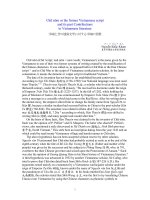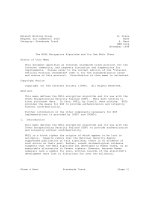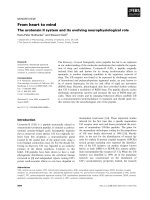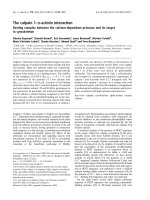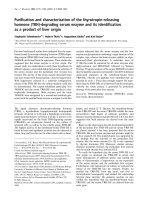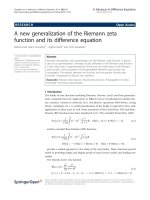Exploring the dynamic assessment paradigm and its usefulness at assessing learning potential of schizophrenia patients
Bạn đang xem bản rút gọn của tài liệu. Xem và tải ngay bản đầy đủ của tài liệu tại đây (2.22 MB, 187 trang )
EXPLORING THE DYNAMIC ASSESSMENT
PARADIGM AND ITS USEFULNESS AT
ASSESSING LEARNING POTENTIAL OF
SCHIZOPHRENIA PATIENTS
HO YAN YIN
(Ph.D.(Psychology), NUS)
A THESIS SUBMITTED
FOR THE DEGREE OF DOCTOR OF
PHILOSOPHY IN PSYCHOLOGY
DEPARTMENT OF PSYCHOLOGY
NATIONAL UNIVERSITY OF SINGAPORE
2011
I
Acknowledgement
This has been a long journey which without the support of these people will
not have been possible. I will like to thank my supervisor, Dr Steven Graham,
for the guidance he provided me all these years. This project would also not
have been possible without the support of all doctors, nurses, and allied health
workers from the psychiatric wards of NUH and IMH. I want to give a special
thanks to all my participants and their caregivers. Thank you for sharing your
experiences with me. To fellow FBIers, I really appreciate your friendship.
Thank you Yong Hao for your statistic advice. I also need to thank Philip and
Guan Thye at ARI for their kind understanding when I had to go AWOL
because of this. And not to be forgotten, my husband and my daughter, this is
for you.
II
TABLE OF CONTENTS
Chapter 1: Schizophrenia and Cognition Impairment … ……. 1
The Origin of Schizophrenia ……………………………… …………… 1
Diagnosing Schizophrenia ……………………………………… ……… 4
Cognitive Deficits in Schizophrenia Patients …………………… 6
The Relationship between Cognitive Impairments and Functional
Outcomes Among Schizophrenia Patients 10
The Relationship between Cognitive Impairments and Schizophrenia
Symptoms 12
Negative Symptoms and its Relationship to Functional Outcomes of
Schizophrenia Patients 15
Concluding Comments on Cognitive Deficits and Functional Outcomes
of Schizophrenia Patients 18
Chapter 2: The Role of Cognitive Rehabilitation in the Treatment for
Schizophrenia……………………………………………………………… 20
Treating Schizophrenia … ……….….…20
Antipsychotic Medications and its Effects on Cognitive Deficits and
Functional Outcome of Schizophrenia Patients 21
Characteristics of Cognitive Rehabilitation Programs………… … 24
The Efficacy of Cognitive Rehabilitation Programs………………… … 26
Translating Improvement in Cognitive Functions into Functional
Improvement…………………………………………………………… 30
Chapter 3: Dynamic Assessment and the Assessing of Learning
Potential…………………………………………………………………… 42
Historical Roots of Dynamic Assessment……………… …………… …42
Reasons behind Increased Interest in Dynamic Assessment 45
The Different Applications of Dynamic Assessment …………………… 48
III
Concept of Learning Potential …………………… ………………… 51
The Intervention Session within the Dynamic Assessment
Paradigm…… ………………………54
Chapter 4: Study 1……………………………… ………………………… 56
Using Wisconsin Card Sorting Test to Assess Schizophrenia Patients……60
The Design of Study 1 …………… …………………………………64
Participants……………………………………………………………… 66
Materials………………………………………………………………… 68
The Wisconsin Card Sorting Test (WCST)…………… ………………68
Wechsler Abbreviated Scale of Intelligence (WASI)………………… 72
The Positive and Negative Syndrome Scale (PANSS)………… … 72
Procedure………………………………………………………………… 73
DA Intervention……………………… ….……………………… … 74
Results……………………………………… ……………………….… 76
Discussion………………………………… …………………….…….….88
Interpreting the Results of Study 1…………… ……… …… 88
Addressing Possible Concerns that the Nature of the DA Intervention
Improves Performance by Revealing Too Much About the WCST
Rules 90
Engaging in Intentional Mediation for the Assessment of Learning
Potential………………… … 93
Using Dynamic Assessment to Assess Rehabilitation Readiness of
Schizophrenia Patients………… ….96
Possible Motivation Effects on the Group WCST Intervention
Results……… ….98
Limitations ……….101
Conclusions from Study 1 ………… 102
IV
Chapter 5: Study 2……………… …………………………………………104
The Design of Study 2……………………… ………………………… 115
Participants…………… ……………………………………………… 116
Materials………………… ………………………… …………….……117
Procedure…………… …………………………… ……………… …117
Results…………………………………………………………………….118
Discussion……………………………………………………………… 120
Interpreting the Results of Study 2………………… …… 121
The Effect of Age ………… 123
The Effect of Antipsychotic Medication 126
The Effect of Negative Symptoms 127
Learning Potential as an Independent Construct that is Useful in
Assessing Rehabilitation Readiness … 129
Qualitative Analysis of Rehabilitation Outcome 131
Conclusions from Study 2 ……… 136
Chapter 6: Conclusion and Reflection…………………………….……… 138
The Ceiling Effect from the Dynamic Assessment Version of the
Wisconsin Card Sorting Test ……………….….…139
The Non-Utilisation of DA Strategies Despite Good Learning Potential
Statuses… …………………….……………… 140
Determining Learning Potential - Categorical or Dimensional
Approach? ……………….… 142
Small Sample Size Effects on Study Results …………………… 143
Future Research Direction…………………… …………………………144
The Issue of Clinical Utility ……………… 145
Dynamic Assessment Complements Conventional Assessment 148
V
Operationalization of the Zone of Proximal Development using the
Dynamic Assessment version of the Wisconsin Card Sorting Test … 148
Concluding Comments ………………………… 149
List of References………………… ………………………………….… 151
Appendices……………………… ……………………………… …… 172
Appendix A: Demographics Questionnaire………………… …….….172
Appendix B: Ethics Approval Document………………….… …….… 176
VI
SUMMARY
Schizophrenia is a debilitating illness which can impede the functional
outcomes of its sufferers even as the illness' symptoms, specifically positive
symptoms, have subsided. Researchers and clinicians seek ways to alleviate
the negative impact of schizophrenia by studying cognitive deficits' effect on
patients' functional outcomes, and possible rehabilitation methods to minimise
the impact of these deficits. While the efficacy of rehabilitation effects are
generally positive, these intervention programs are time and labour intensive.
Hence there is an imperative to find a better fit between a patient’s
rehabilitation potential and rehabilitation needs, so that limited rehabilitation
resources are fully utilised and not wasted on unsatisfactory outcomes. This
thesis examines the Dynamic Assessment (DA) paradigm (which involves pre-
test, intervention, and post-test phases) as a possible tool in the assessment of
Learning Potential – a construct central to the DA paradigm that has been
shown to provide indication of schizophrenia patients' rehabilitation potential.
DA can potentially enables clinicians to make better informed referral
decisions by matching a patient’s rehabilitation potential to the appropriate
rehabilitation programs. Despite the advantages that DA also provide in terms
of allowing clinicians to more fully observe patients' rehabilitation readiness,
and its promising practical applicability in predicting Learning Potential, few
studies have systematically examined the efficacy of DA. Study 1 therefore
investigated whether DA intervention produced performance improvements
over-and-above those that would be expected from simple practice effects.
Study 2 tested the relationship between Learning Potential (DA’s core
construct) and intellectual function (IQ), age, medication dosage, and negative
VII
symptoms. Study 1 findings indicated that DA intervention resulted in
performance improvements in schizophrenia patients that were over-and-
above the practice effect. Study 2 indicated that there was no relationship
between Learning Potential and intellectual function, age, medication dosage,
or negative symptomatology of the schizophrenia patients studied, suggesting
that Learning Potential is a unique construct assessed by DA. Thus, this thesis
supports the assertion that DA provides a unique prediction about a
schizophrenia patient’s Learning Potential, and paves the way for future
longitudinal studies to examine more directly the relationship between
Learning Potential and rehabilitation and long-term functional outcomes in
patients with schizophrenia.
VIII
List of Tables
Table 1. Different Approaches used in Dynamic Assessment ………… …52
Table 2. Demographics and Clinical Characteristics of Participants……… 67
Table 3. Average Performance by Group on the Total Correct Responses
(TCR) measure of the Wisconsin Card Sorting Test …… 78
Table 4. Average Performance by Group on the Perseverative Errors (PE)
and the Nonperseverative Errors (NPE) measures of the Wisconsin
Card Sorting Test 81
Table 5. Average Performance by Group on the Categories Completed,
Conceptual Level Responses, Failure to Maintain Set, Trials to
First Category, and Perseverative Responses Measures of the
Wisconsin Card Sorting Test … 87
Table 6. Employment Status of Schizophrenia Patients in Group DA
Intervention… 135
IX
List of Figures
Figure 1. Vygotsky’s Zone of Proximal Development (ZPD) …… …….44
Figure 2. Design of Study 1 …………………………………………… …65
Figure 3. A representation of the Wisconsin Card Sorting Test (WCST) … 69
Figure 4. A flowchart depicting the procedure of the Dynamic Assessment
(DA) intervention using the Wisconsin Card Sorting Test (WCST) …… 75
Figure 5. Pre- and Post-Test Performances on the Total Correct Responses
(TCR) measure of the Wisconsin Card Sorting Test ………………… … 77
Figure 6. Pre- and Post-Test Performances on the Perseverative Errors (PE)
measure of the Wisconsin Card Sorting Test ………… ………………… 80
Figure 7. Pre- and Post-Test Performance on the Nonperseverative Errors
(NPE) measure of the Wisconsin Card Sorting Test .…………… 84
Figure 8. Pre- and Post-Test Performance on the Total Correct Responses
(TCR) measure by Individual Participants in Group DA Intervention 102
Figure 9. Performance on the Total Correct Responses (TCR) measure of the
Wisconsin Card Sorting Test (WCST) by Different Learning Potential
Groups 109
Figure 10. Design of Study 2 …………………………………………… 116
1
Chapter 1: Schizophrenia and Cognitive Impairment
Schizophrenia is a mental disorder that has intrigued clinicians and researchers
alike since its description by Kraepelin in the late 19
th
century. Since then,
there have been many scholarly discussions and scientific studies of this
debilitating illness, ranging from the causes of schizophrenia, the symptoms
displayed by schizophrenia patients, the development of the illness, the
treatment choices, and the treatment outcomes of schizophrenia. This thesis
starts with a literature review of the cognitive deficits typically observed in
schizophrenia patients. An understanding of these cognitive deficits will be
helpful in formulating interventions aimed at ameliorating these cognitive
deficits. The efficacy of cognitive rehabilitation for schizophrenia patients is
reviewed in Chapter 2, followed by an introduction to the Dynamic
Assessment (DA) paradigm (which has been proposed as being helpful in
predicting rehabilitation potential of schizophrenia patients) in Chapter 3.
Chapters 4 and 5 describe the experimental studies of this thesis that were
aimed at investigating the viability of Dynamic Assessment, and an overall
discussion of these results and concluding remarks is set out in Chapter 6.
The Origin of Schizophrenia
Our understanding of mental disorders, such as schizophrenia, has not always
been founded on scientific beliefs. Until the time of Hippocrates, any
understanding of mental illness was guided by influential thinkers who
asserted their (sometimes misguided) beliefs. Hippocrates, who is typically
regarded as the father of medicine, began a more evidence based biological
approach towards mental illness, which he termed as madness, by attributing
2
its aetiology to physiological rather than supernatural factors. Hippocrates’
biological approach to mental illness was however interrupted during the
Middle Ages under the strong influence of the church, and mental illness was
once again attributed to supernatural forces such as witchcraft or the devilish
possession of the body (Palha & Esteves, 1997).
The Age of Reason, or the Enlightenment, in the 17
th
and 18
th
century, was the
scientific era of great thinkers and scientists such as Copernicus, Galileo,
Descartes, Pascal and Newton. During this period, understanding and debate
about mental illness once again took on a more scientific approach. Another
important reform during this period was the more humane treatment of mental
patients (Palha & Esteves, 1997). In the 19
th
century, the first case of
schizophrenia as a disorder akin to what we understand it in today’s time, was
documented and reported in Bethlem Hospital. It was a patient by the name of
James Tilly Matthews who had been in Bethlem Hospital for thirteen years
before his case was documented and described by doctors (Stone, 2006). It
was also during the 19
th
century that Benedic Morel first coined the term
“dementia praecox” to describe schizophrenia and also the first to attribute
hereditary factors behind the cause of schizophrenia (Palha & Esteves, 1997).
However, it was only in the late 19
th
century before Kraepelin provided us
with a comprehensive description of schizophrenia after a long period of
careful observations of his patients. He broadened Morel’s notion of dementia
praecox and added the idea of predisposed diffused cerebral pathology into his
description of the disorder (Palha & Esteves, 1997). He also considered what
3
we now term “negative symptoms”, as the fundamental symptoms of
schizophrenia (Andreasen, 1997). Eugen Bleuler further refined this diagnostic
category by dividing the symptoms into two broad categories which he
referred to as fundamental and accessory symptoms. The fundamental
symptoms, which are similar to today’s notion of “negative symptoms”,
included the loss of continuity of associations, loss of affective
responsiveness, loss of attention, loss of volition, ambivalence, and autism. On
the other hand, the accessory symptoms, which are similar to today’s “positive
symptoms”, included delusions and auditory hallucinations (Andreasen, 1997).
Although Kraepelin and Bleuler helped to recognize the different types of
symptoms present in schizophrenia patients, one of the earliest and most
prominent users of the terms “positive symptoms” and “negative symptoms”
(that we use today) was Hughlings-Jackson who thought of negative
symptoms as a loss of normal functioning, and positive symptoms as an
exaggeration of normal functioning (Andreasen, 1997).
Following Kraepelin’s and Bleuler’s description of schizophrenia, negative
symptoms were increasingly emphasized as the central symptoms of the
disorder, until this emphasis later shifted in the 1960s and 1970s to focus on
positive symptoms, for a variety of reasons. One of these reasons was the
influence of Kurt Schneider’s work, who noted that the inability to distinguish
between self and not-self and a loss of the sense of personal autonomy were
critical components of schizophrenia. As these impairments were usually
caused by delusions and hallucinations, the emphasis therefore shifted to
positive symptoms of schizophrenia. Another reason was the fact that negative
4
symptoms were difficult to define and rate reliably, often because these
symptoms were usually also found in healthy people (with subtle differences
in severity and frequency) hence resulting in the increased risk of over-
diagnosing schizophrenia in the healthy population. The popular acceptance of
Schneider’s ideas during this period, in confluence with the difficulty in
defining negative symptoms, resulted in the shift of emphasis to positive
symptoms which appeared more clearly as markedly abnormal behaviours.
This emphasis was strengthened especially when these symptoms were
included as diagnostic criteria such as in the third edition of the Diagnostic
and Statistical Manual of Mental Disorders (DSM) (Andreasen, 1997).
Today, there is a more balanced view of both positive and negative symptoms
as important features of schizophrenia (Andreasen, 1997), and our
understanding of schizophrenia will no doubt continue to evolve as research
continues on this disorder. Nevertheless, acknowledgement must be given to
those who came before us in the study of schizophrenia, especially the early
writings of Kraepelin and Bleuler who provided us with a conceptual
foundation for the study and understanding of schizophrenia today.
Diagnosing Schizophrenia
There are two alternative systems that clinicians can use to diagnose mental
disorders: the Diagnostic and Statistical Manual of Mental Disorders (DSM)
and the International Classification of Diseases (ICD). The DSM was
developed in the United States, and has gone through many editions – the
current edition is the revised fourth edition (DSM-IV-TR) with a fifth edition
5
in the pipeline which is expected in the near future (American Psychiatric
Association, 2010).
The ICD is maintained by the World Health Organization (WHO), and
currently its tenth edition (ICD-10) has been in use since 1994. Other than
diagnostic information, the ICD-10 also provides a unified method for the
compilation of national mortality and morbidity statistics by various member
states of the WHO (World Health Organization, 2011).
Despite their differences, the two diagnostic systems are roughly equivalent
and the choice of diagnostic systems depends very much on the locale in
which the clinician is practising, and also the clinician’s training and
preference. To diagnose a person with schizophrenia by DSM-IV-TR, the
clinician rates the person on six diagnostic criteria. The person must have two
or more of the following symptoms for a significant portion of time during a
1-month period: delusions, hallucinations, disorganized speech, grossly
disorganized or catatonic behaviour, or negative symptoms (Criterion A).
However, only one Criterion A symptom is required to meet the diagnosis if
the symptom consists of bizarre delusions or auditory hallucinations. The
diagnosis can also be made if some signs of the disorder persisted for at least
six months (Criterion C) and that there are at least one month of symptoms
that meet Criterion A. The conditions of schizophrenia also include
impairment in social or occupational functioning (Criterion B). Finally, the
diagnosis of schizophrenia can only be finalized when schizoaffective or mood
disorder (Criterion D) and physiological effects of a substance or a general
6
medical condition (Criterion E) are ruled out as the causes of the symptoms. If
the person has a history of autistic disorder or another pervasive
developmental disorder, schizophrenia can be added to the diagnosis if
delusions or hallucinations are present for at least a month (Criterion F)
(American Psychiatric Association, 2000).
To meet the ICD-10 criteria for a diagnosis of schizophrenia, nine symptoms
are considered, and are categorized into two groups. The first group contains
four positive symptoms such as thought echo, insertion or withdrawal or
broadcasting, delusions, and hallucinations. The second group contains five
symptoms with some negative symptoms like catatonic behaviours,
disorganized thoughts, blunted affect, and marked apathy. Meeting the ICD-10
diagnosis of schizophrenia requires the presence of at least one very clear
symptom (and usually two or more if less clear-cut) from the first group of
symptoms. Diagnosis can also be made if at least two symptoms from the
second group of symptoms have been present for most of the time for at least
one month. The ICD-10 also acknowledges that a decrease in social and
functioning level can precede the onset of schizophrenia symptoms. Similar to
DSM-IV-TR, schizophrenia can only be diagnosed when extensive mood
disturbances, and other organic causes like brain disease or substance use have
been ruled out (World Health Organization, 1992).
Cognitive Deficits in Schizophrenia Patients
Besides the positive and negative symptoms seen in schizophrenia patients,
cognitive deficits are also a central feature of schizophrenia. The domains of
7
cognitive deficits suffered by patients include speed of processing,
attention/vigilance, working memory, verbal learning and memory, visual
learning and memory, reasoning and problem solving, verbal comprehension,
and social cognition (Nuechterlein et al., 2004). It was reported that when
comparing their means on standard neuropsychological tests, 80% of
schizophrenia patients performed at least one standard deviation below
matched healthy controls, and 50.6% of schizophrenia patients performed at
least two standard deviations below matched healthy controls (Wilk et al.,
2004). Besides identifying the cognitive deficits seen in schizophrenia
patients, it is also important to understand how these deficits manifested
throughout the span of the disorder so that clinicians can anticipate such
changes and make timelier and more appropriate treatment decisions for these
patients.
Two trajectories have been proposed for the cognitive changes in
schizophrenia patients: one trajectory that proposes a progressive decline of
cognitive abilities and another trajectory that proposes a stabilization of
cognitive deficits after the onset of schizophrenia. A suggestion for the
trajectory of cognition deficits decline among schizophrenia patients is that
cognitive function will deteriorate the most in the first five years of illness.
This is followed by a stabilization of function or even improvement. Further
deterioration may occur especially if negative symptoms persist. Bilder et al.
(1992) assessed the cognitive function of three groups of participants: first-
episode schizophrenia patients, chronic schizophrenia patients, and healthy
participants. By examining the results from the subtests of the Wechsler Adult
8
Intelligence Test - Revised (WAIS-R) administered to the three groups of
participants, poorer performance on the WAIS-R by the first-episode
schizophrenia patients and the chronic schizophrenia patients compared to the
healthy controls, suggested poorer cognitive function for both patient groups.
However, when the severity of cognitive deficits was compared between the
first-episode patients and the chronic patients, the severity of cognitive deficits
was less in the first-episode patients compared to the chronic patients. By
definition, the length of illness was longer for the chronic patients compared to
the first-episode patients, and their relatively poorer cognitive function could
therefore be explained as the result of progressive deterioration of the
cognitive function with time, lending support to the observation of slow
progressive deterioration of cognitive function in schizophrenia patients. This
trajectory of slow cognitive decline in schizophrenia patients has been termed
the neurodegenerative model.
On the other hand, some studies have suggested that cognitive deficits remain
relatively stable over long periods of time following the onset of
schizophrenia. A review of longitudinal studies of cognition of schizophrenia
patients found that verbal skills, memory, and pre-attentional information
processing were the most stable cognitive deficits, while complex attention
and concentration, set-response-shift, and attention span were the less stable
deficits (Rund, 1998). Rund (1998) suggested that the more stable cognitive
deficits did not show any decline beyond what was expected from normal
aging over time. Rund (1998) also suggested that the less stable deficits were
episodic-like and related to the fluctuation of symptoms. In addition some
9
other cognitive deficits were characterized as intermediate factors, meaning
that they were prominent in acute psychotic state and subsided (although did
not completely disappear) during remission.
These two postulations about the trajectory of cognitive decline can be viewed
as opposite ends of the spectrum seen among schizophrenia patients. The only
similarity between the two trajectories is that cognitive function shows some
improvement following remission after the acute phase of the illness, after
which the two trajectories differ in the progression of these deficits. From the
clinicians’ point of view, the progression of the deficits plays an important
part when devising a treatment and rehabilitation plan for patients. If a
patient’s cognitive functions progressively deteriorate, the rehabilitation plan
may need to include provisions for increasing aid to the patient as the patient's
cognitive status declines. However, if the deterioration eventually stabilises,
the more efficient rehabilitation plan may be to wait for the stabilisation before
teaching coping strategies for residual deficits. The characteristic of the course
of cognitive deficits therefore has implications for treatment and rehabilitation
planning.
To shed more light on the trajectory of cognitive decline in schizophrenia
patients, Bonner-Jackson, Grossman, Harrow, and Rosen (2010) followed a
group of patients with different mental illnesses including schizophrenia, other
types of psychotic disorders (psychotic depression, psychotic bipolar
disorders), and nonpsychotic disorders (nonpsychotic depression) over a 20-
year period. Cognitive function, specifically processing speed and the ability
10
to access general knowledge, was assessed over seven time points over the 20-
year period (once at acute phase upon hospitalization and six more times
spanning the next 20 years). The results showed that schizophrenia patients
were most impaired at the acute phases compared to the other mental illness
groups. This acute phase was followed by a recovery of some cognitive
functions and relative stability in cognitive status over the 20-years period.
This study therefore provides support to Rund’s (1998) view of the post-acute-
phase stability of cognitive status over time in schizophrenia patients. Such a
projected trajectory for cognitive function in schizophrenia patients suggests
that treatment and rehabilitation planning should incorporate interventions that
can help patients cope with the effects of residual cognitive deficits. There is
therefore a pressing need for tools to help clinicians more accurately assess the
type and level of intervention required by their patients based on their post-
acute-phase residual cognitive function deficits.
The Relationship between Cognitive Impairments and Functional
Outcomes Among Schizophrenia Patients
With cognitive deficits being established as a core feature of schizophrenia, it
would be important to know the impact these deficits have on the functional
outcome of schizophrenia patients (Tan, 2009). Research on functional
outcomes in schizophrenia patients usually involves studies at the level of
community outcome (e.g., being able to work or go to school), social problem
solving ability and psychosocial skill acquisition. A review by Green, Kern,
Braff, & Mintz (2000) suggested that 20% to 60% of variance in functional
outcomes of patients could be explained by composite measures of cognition.
11
Further analysis found significant relationships between specific cognitive
functions and functional outcomes with medium to large effect sizes. For
example, it was found that executive functioning (as measured by the
Wisconsin Card Sorting Test) was related to patients' community outcome.
This suggests that studying a schizophrenia patient’s performance on tests of
executive function can provide an indication of how the patient is going to
function in daily life activities such as in school or at work. A recent study by
Nuechterlein et al. (2011) also showed that cognitive functions such as
working memory, verbal memory and processing speed, and attention and
early perceptual processing abilities measured at a stabilised phase of the
illness process among first episode schizophrenia patients predicted vocational
outcome. Nuechterlein et al. (2011) recruited 47 patients and assessed their
cognition with the Degraded Stimulus Continuous Performance Test, the Span
of Apprehension, the Trail Making Test, the Digit-Span Distractibility Task
and the California Verbal Learning Test, as well as assessed the patients'
functional outcomes by the work section of the Social Adjustment Scale. It
was found that these cognitive functions accounted for 52% of the variance
related to whether the patients returned to paid work or schooling within 9
months. Thus cognitive deficits suffered by schizophrenia patients appear to
be related to their functional outcomes: poorer functional outcome is
associated with poorer cognitive function.
There is no doubt that the reduction of psychotic symptoms is a priority goal
when treating schizophrenia patients, but the next stage of treatment could be
to help patients with their functional outcomes by focusing on their cognitive
12
deficits. For example, using cognitive rehabilitation programs to help return
them as closely as possible to their pre-morbid level of cognitive function.
With the evidence pointing towards a relationship between cognitive deficits
and a patient’s functional outcome, clinicians will need to consider these
cognitive deficits when planning any treatment approach that is aimed at
improving a patient’s functional outcome (Gopal & Variend, 2005; Green,
Kern, & Heaton, 2004). Therefore, it is important to incorporate into the
treatment, approaches that target cognitive functions of schizophrenia patients
– approaches such as cognitive rehabilitation which will be discussed in more
detail in the following chapter.
The Relationship between Cognitive Impairments and Schizophrenia
Symptoms
Besides charting the course of cognitive deficits, researchers have also
attempted to establish the relationship between cognitive deficits and the
symptoms of schizophrenia. It was discussed previously that although certain
cognitive deficits seen in schizophrenia patients may be episodic-like and less
stable, and linked to fluctuations of symptoms (see Rund (1998)), cognitive
performance is generally thought to remain stable despite variation of
symptomatology over time (Heaton et al., 2001). With only modest
relationship between negative and disorganization symptoms and cognitive
ability (correlation between -0.15 to 0.30), and a minimal relationship between
positive symptoms and cognitive performance, studies seem to suggest that
cognitive impairment seen in schizophrenia patients is generally independent
from their schizophrenia symptoms (Gold, 2004). Family studies further
13
support the dissociation between cognitive impairments and symptoms. The
(symptom free) first-degree relatives of schizophrenia patients show marked
cognitive impairments similar to the patients themselves (Egan et al., 2001),
despite their lack of (even sub-threshold) symptoms, thus supporting the
notion that cognitive deficits and clinical symptoms of schizophrenia are
independent of each other (Gold, 2004).
As a cautionary note, a diagnosis of schizophrenia is however a categorical
boundary, as it is of course possible that non-affected relatives are closer to
that boundary than unrelated healthy controls. A closer look at research
findings will show that the independence of symptoms and cognitive deficits
of schizophrenia patients is mostly for positive symptoms and not negative
symptoms. For example, Potter and Nestor (2010) found that schizophrenia
patients with more decline in intellectual functions tended to have more
negative symptoms. A group of schizophrenia patients (n = 73) was recruited
in an attempt to validate a model of cognitive subtypes of patient (i.e., three
subtypes namely intellectual preserved - patients whose intellectual function
did not change from premorbid levels; intellectual compromised - patients
with consistently low intellectual function; and intellectual deteriorated -
patients whose intellectual function declined after the onset of the disorder). A
comprehensive neuropsychological assessment was conducted that included
the Wechsler Adult Intelligence Scale, Wechsler Memory Scale, Wisconsin
Card Sorting Test and Trail Making Test, as well as the Positive and Negative
Syndrome Scale which was also administered to assess the patients'
schizophrenia symptoms. The results showed significant difference in
14
cognitive functions in the three groups of patients with progressively poorer
cognitive functions in the order of the intellectual preserved group, the
intellectual deteriorated group, followed by the intellectual compromised
group. The results also showed that the intellectual compromised group had
significantly higher negative symptom ratings, followed by those of the
intellectual deteriorated group, compared to the negative symptom ratings of
the intellectual preserved group. The intellectual compromised group and the
intellectual deteriorated group also had more negative symptoms than positive
symptoms while the opposite was true for the intellectual preserved group
(who had more positive symptoms than the intellectual deteriorated group).
Thus Potter and Nestor (2010)’s results supported the dissociation of positive
symptoms from cognitive functions (since having more positive symptoms
was associated with higher cognitive functions i.e., among the intellectual
preserved group, and having less positive symptoms was associated with
poorer cognitive functions i.e., among the intellectual deteriorated group).
However for negative symptoms, the pattern of manifestation across the
groups of schizophrenia patients consistently showed poorer cognitive
function was associated with higher ratings of negative symptoms. This shows
that the relationship between schizophrenia symptoms (specifically positive
versus negative symptoms) and cognitive deficits is not straight-forward. The
moderate relationship between negative symptoms and cognitive deficits has
received further evaluation, and the findings that bear relevance to functional
outcomes of schizophrenia patients are reviewed briefly in the following
section.
15
Negative Symptoms and its Relationship to Functional Outcomes of
Schizophrenia Patients
Schizophrenia is characterized by both positive and negative symptoms, but
both types of symptoms have different patterns of manifestation during the
course of the illness. While positive symptoms tend to remit with medication,
negative symptoms tend to be more stable and persistent. Negative symptoms
also tend to appear in the later stages of the acute phase of the illness or at the
later stages of the illness among first-episode schizophrenia patients
(Addington, 2000). However, what draws the attention of researchers
specifically to the negative symptoms of schizophrenia is its relationship with
the cognitive functions of patients. As discussed earlier, research findings tend
to support the idea that negative symptoms are related to cognitive function of
schizophrenia patients with more severe negative symptoms associated with
poorer cognitive functions (see Potter & Nestor (2010)). Because of the
relationship between cognitive functions and functional outcome of
schizophrenia patients, the association between negative symptoms and
cognitive functions may indicate that negative symptoms have some
association with functional outcomes of patients too. This has prompted
researchers to investigate other possible interactions between negative
symptoms and the functional outcome of schizophrenia patients.
One such area of research is the predictive value of negative symptoms for the
functional outcomes of schizophrenia patients. Siegel et al. (2006) recruited 98
schizophrenia patients and assessed them with the Scale for the Assessment of
Positive Symptoms (SAPS), Scale for the Assessment of Negative Symptoms
